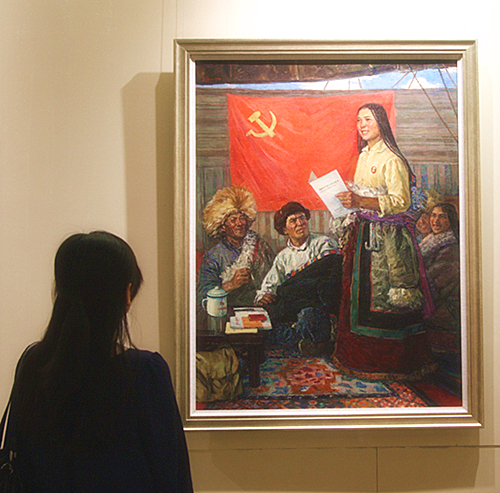Tibetan art exhibition kicks off in Beijing
|
|
|
A student is enjoying the artworks of the Art Exhibition for the 60th Anniversary of Tibet's Peaceful Liberation in Beijing on June 14 [By Li Huiru/China.org.cn] |
Southwest China's Tibet Autonomous Region has seen tremendous changes since its liberation in 1951.
In order to educate people on the progress of democracy, freedom and human rights in Tibet, an art exhibition for the 60th anniversary of Tibet's peaceful liberation kicks off at the China People's Revolution Military Museum on June 14.
The exhibition displays 215 pieces of artworks with a wide range of themes including history, man and nature, traditional culture, customs, social progress, and so on.
Curators said the exhibit will showcase the prosperous life of Tibetans under the leadership of Communist Party of China and promote cultural exchange and integration.
|
|
|
People look at the artworks of the Art Exhibition for the 60th Anniversary of Tibet's Peaceful Liberation in Beijing on June 14 [By Li Huiru/China.org.cn] |
Tibet has become a core subject of contemporary Chinese art since the 1930s. This is the third large-scale Tibetan art exhibition since the founding of the People's Republic of China.
The featured art at this exhibit are divided into five topics: "Down to the Earth," "Perfect Harmony of Salt, Milk and Tea," "A New City with a Golden Peak," "Deep Chasm Turned into Thoroughfare" and "the Sunlit Tibetan Plateau." The five topics cover modern and contemporary Chinese art about Tibet.
The Qinghai-Tibet Plateau is the homeland of more than ten Chinese ethnic groups. For generations, they have lived together in peace and harmony.
According to Wu Changjiang, executive vice chairman of the Chinese Artists Association (CAA), this art exhibit has deep significance. It not only presents the aesthetic standards for the Tibetan theme, it also has important academic and literary value, he said. Moreover, it will help those who are interested in Tibet gain a more in-depth understanding of Tibetan historical, cultural and artistic achievements.
Jointly sponsored by the China Association for Preservation and Development of Tibetan Culture, China Artists Association and Capital Normal University, the art exhibition will run for 11 days, ending June 25.
 0
0 








